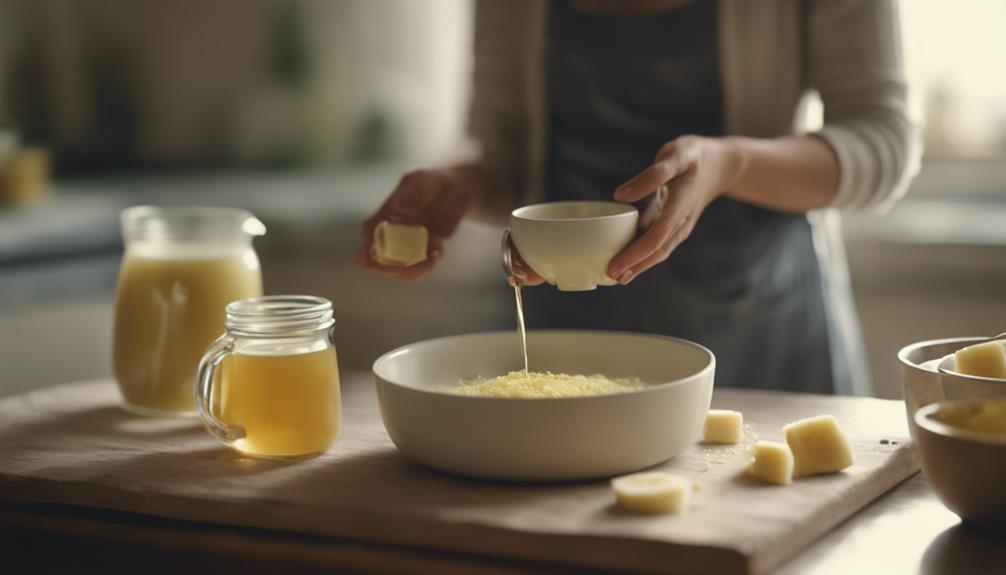To help a baby with a bellyache, start with gentle tummy massages to alleviate gas and promote digestion. Applying a warm compress can provide relief from stomach discomfort and promote circulation. Try bicycling leg motion to aid bowel movements and reduce colic symptoms. Essential burping techniques are vital for gas relief after feeding. Gas relief strategies like gentle massages and using anti-colic bottles can be effective. Consider dietary factors like breast milk for easy digestion and avoiding gas triggers. If signs persist, seek medical advice promptly. Monitoring the baby's diet and seeking reliable help are important preventive measures. More tips await.
Key Takeaways
- Gentle tummy care techniques like gas relief massages and leg bicycling can alleviate bellyaches.
- Applying warm compresses on the abdomen can soothe discomfort and promote digestion.
- Proper burping practices after feeding can help relieve gas and prevent bellyaches.
- Monitoring baby's diet to avoid gas triggers like dairy and introducing fiber-rich foods gradually.
- Seek medical advice if the baby shows signs of distress, persistent symptoms, or fever above 100.4°F.
Gentle Tummy Massages
Gentle tummy massages can be a soothing method to alleviate gas and constipation in babies. When your baby is experiencing stomach discomfort due to gas or constipation, gently massaging their tummy can help promote digestion and ease their discomfort.
These infant massage techniques are particularly beneficial for moving trapped gas through the digestive system, providing relief for gas pains and colic. A 15-minute protocol involving moderate pressure on the baby's abdomen, face, and limbs can aid in resolving abdominal discomfort.
Regular tummy massages not only help alleviate immediate symptoms but also contribute to overall digestive health for your baby. By incorporating gentle tummy massages into your routine, you can provide your little one with a natural and effective way to address any stomachaches they may be experiencing.
Warm Compress

When it comes to helping your baby's bellyache, consider the comforting benefits of a warm compress. The gentle warmth can provide relief by relaxing muscles and promoting better blood circulation.
Remember to exercise caution with the temperature to guarantee your baby's safety and comfort throughout the process.
Soothing Warmth for Relief
To help ease your baby's bellyache, consider applying a warm compress gently to their abdomen for relief.
Here's why it can be beneficial:
- Relief from Abdominal Discomfort: The warmth from the compress can help alleviate your baby's stomach pain by promoting muscle relaxation and easing gas pains or constipation.
- Muscle Relaxation: The gentle heat from the warm compress can aid in relaxing the muscles in your baby's abdomen, providing a soothing effect that may help ease their discomfort.
- Promotes Circulation: By using a warm compress on your baby's stomach, you can help improve circulation in the area, which can further aid in relieving any tension or pain they may be experiencing.
Remember to always make sure the warm compress is warm but not hot, to prevent any burns or discomfort for your little one.
Applying a warm compress correctly can be a simple yet effective way to provide relief for your baby's bellyache.
Proper Application Technique
How can you guarantee the proper application of a warm compress to soothe your baby's bellyache effectively?
To apply a warm compress to your baby's abdomen, start by soaking a clean cloth in warm water. Remember to wring out the excess water to prevent drips. Gently place the warm compress on your baby's belly, making sure it covers the area comfortably. The warmth from the compress aids in relaxing the abdominal muscles, offering relief from discomfort due to gas or constipation.
When applying the warm compress, make sure it isn't too hot to prevent any harm to your baby's sensitive skin. Monitor your baby's reaction closely. If your baby shows signs of discomfort or irritation, remove the warm compress immediately.
It's important to be attentive and responsive to your baby's cues during this process to ensure their comfort and safety.
Bicycling Leg Motion
Engage your baby in the gentle motion of bicycling their legs to help alleviate stomach discomfort and release trapped gas in their digestive system. This simple exercise can make a significant impact on your baby's comfort and well-being. Here are three key benefits of incorporating bicycling leg motion into your baby's routine:
- Relieving Gas: By gently moving your baby's legs in a pedaling motion, you can help release trapped gas in their digestive system, reducing the discomfort associated with bloating and gas pains.
- Reducing Colic Symptoms: Bicycling your baby's legs can aid in alleviating colic symptoms by promoting better digestion and easing any gas-related issues contributing to their discomfort.
- Aiding Bowel Movements: This leg exercise can also help stimulate bowel movements and relieve constipation, providing relief and promoting healthy digestion for your little one.
Incorporating bicycling leg motion into your baby's routine can be a simple yet effective way to address bellyaches and promote overall comfort.
Proper Burping Techniques

To properly burp your baby for gas relief, it's essential to employ correct techniques. Holding your baby against your chest or sitting them upright can aid in releasing trapped air.
Burping for Gas Relief
To help relieve gas in your baby's stomach and reduce discomfort, utilize proper burping techniques such as holding your baby upright against your chest and gently patting or rubbing their back. Here are some essential tips for effective burping for gas relief:
- Positioning: Hold your baby in an upright position against your chest with their head resting on your shoulder to help release trapped gas in the stomach.
- Patting or Rubbing: Gently pat or rub your baby's back in an upward motion to encourage burping and relieve gas buildup.
- Timing: Remember to burp your baby after feeding or during breaks to prevent gas from accumulating and causing discomfort.
Burping Frequency Tips
For best gas relief and comfort for your baby, remember to burp them every 2-3 ounces while bottle-feeding or after each breast during breastfeeding. Important burping techniques are vital to prevent gas buildup, which can lead to bellyaches in infants.
Holding your baby upright against your chest and gently patting or rubbing their back helps release trapped air that may cause discomfort. This practice is essential for both breastfed babies and bottle-fed babies to alleviate gas pains and reduce the risk of colic symptoms.
Burping frequency plays a significant role in ensuring your baby's digestive well-being. It's recommended to burp your baby regularly to release any swallowed air during feeding, promoting better digestion and minimizing fussiness.
Gas Relief Strategies
When helping your baby with a bellyache, consider implementing gas relief strategies to ease their discomfort. Here are some techniques to help relieve gas and trapped gas:
- Gentle Massage:
'Gently massaging your baby's tummy in a clockwise motion can help relieve gas and discomfort,' suggests pediatrician Dr. Smith.
- Bicycle Baby's Legs:
'Bicycling your baby's legs by gently moving them in a cycling motion can help release trapped gas,' advises infant care specialist, Nurse Johnson.
- Use Anti-Colic Bottles:
'Consider using anti-colic bottles or nipples designed to reduce air intake during feeding to prevent gas buildup,' recommends the American Academy of Pediatrics.
Dietary Considerations

Consider incorporating dietary considerations to help alleviate your baby's bellyache and promote healthy digestion. When it comes to feeding your little one, opt for breast milk if possible. Breast milk is gentle on the stomach and less likely to cause digestive issues compared to formula feeding. However, if you're formula feeding, choose a gentle and easy-to-digest formula suitable for sensitive tummies. As your baby starts solids, introduce fiber-rich foods gradually to aid digestion and prevent constipation. Be cautious of gas triggers like dairy, citrus fruits, and spicy foods, as these can lead to discomfort in your baby's belly. Additionally, support your baby stays hydrated by offering water between feedings to support digestion and prevent constipation. Monitoring your baby's water intake is essential in maintaining healthy digestion and alleviating bellyaches.
| Dietary Considerations | Tips |
|---|---|
| Breast Milk | Easily digested, less stomach issues |
| Formula Feeding | Choose gentle, easy-to-digest formula |
| Fiber-Rich Foods | Introduce gradually to prevent constipation |
| Gas Triggers | Avoid dairy, citrus fruits, and spicy foods |
Seeking Medical Advice

To safeguard your baby's well-being during a bellyache, promptly seek medical advice if specific concerning symptoms or behaviors arise.
Here are three essential signs that indicate it's time to contact a healthcare provider or pediatrician:
- Fever above 100.4°F (38°C): If your child's tummy troubles are accompanied by a fever of this magnitude, it's vital to seek medical advice promptly to rule out any underlying issues.
- Persistent diarrhea or constipation: Consult a healthcare provider if your baby experiences prolonged diarrhea lasting more than 48 hours or if constipation persists for several days, as this could signal a more serious problem requiring medical attention.
- Extreme distress or unusual symptoms: Signs like continuous crying, extreme fatigue, a rigid belly, or weight loss shouldn't be ignored. Trust your parental instincts and reach out to a pediatrician if you notice any concerning behaviors in your baby's bellyache.
Preventive Measures
Monitor your baby's diet closely to pinpoint and steer clear of potential triggers for bellyaches. Be mindful of food sensitivities and allergies that could be causing discomfort in your baby's stomach. Providing proper nutrition and ensuring adequate hydration are essential for maintaining a healthy gut and preventing stomach issues.
It's vital to seek advice from reliable sources, such as healthcare professionals or reputable organizations like the American Academy of Pediatrics. Websites like HealthyChildren.org and the National Institute of Diabetes and Digestive and Kidney Diseases offer valuable information on infant stomach problems and preventive measures.
Frequently Asked Questions
How Can I Soothe My Baby's Stomach Ache?
To soothe your baby's stomach ache, swaddle for comfort, use white noise to calm, avoid trigger foods like dairy, offer prune juice with doctor's approval for constipation, and contact a healthcare provider if symptoms persist or worsen.
How to Tell if Baby's Stomach Hurts?
When checking if your baby's stomach hurts, watch for signs like excessive crying, refusal to eat, or unusual sleep disruptions. Keep an eye out for symptoms such as diarrhea, constipation, or allergic reactions.
How to Relieve Baby Gas Pain?
To relieve baby gas pain, gently massage their tummy in a clockwise motion, burp them frequently during and after feedings, use anti-colic bottles, encourage tummy time, and consider simethicone drops or gripe water as advised by your pediatrician.
How Do I Know if My Baby Is in Pain?
You can tell if your baby is in pain by watching for signs like excessive crying, refusal to eat, and unusual behavior. Trust your instincts as a parent and seek medical advice promptly if you suspect distress.
Conclusion
To sum up, helping a baby with a bellyache requires patience, gentle care, and a few simple techniques. By incorporating tummy massages, warm compresses, and proper burping techniques, you can provide relief for your little one.
Remember, preventative measures, such as monitoring their diet and seeking medical advice when necessary, are key in ensuring their comfort and well-being.
Just like a delicate dance, soothing a baby's bellyache requires a delicate touch and strategic steps to alleviate their discomfort effectively.









